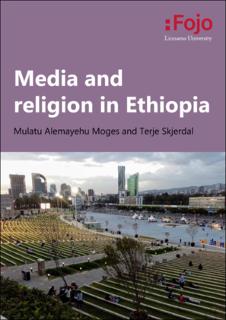| dc.description.abstract | Religion has become an issue in the Ethiopian media. This is a new situation in a country which for many years excluded religious expressions from the public media. With the coming of prime minister Abiy Ahmed and the Prosperity Party in 2018, the principle of the secular state, which is in the Ethiopian Constitution, has been challenged fundamentally. Religion is being brought into official speeches and reflected in the media.
Presenters on state television are seen wearing Orthodox crosses and Muslim hijabs, which was unheard of just five years ago. The new media proclamation which came in 2021 allows religious organizations to apply for broadcasting licences for the first time in the nation’s history. By 2023, between 40 and 50 religious organizations have acquired such a licence. At the same time, religion has also surfaced as a conflict issue in the media. Quarrel within the Ethiopian Islamic Affairs Supreme Council in 2021, dispute around the ownership and use of Meskel Square in Addis Ababa in 2020–22, and an attempt of schism within the
Orthodox church in 2023 are three hot issues which epitomize religious conflict as a topic in the current news scene.
The purpose of this study is to assess the ongoing changes in media and religion in Ethiopia. The researchers have interviewed 20 representatives from the media, the religious community and the
regulator. The study also contains an in-depth analysis of 98 stories on religion which made headlines in ten different media outlets between 2020 and 2023.
The study found that the newfound openness for religion in the Ethiopian media is deficient. The ‘broadcasting licences’ for religious organizations do not permit local radio stations or transmission through terrestrial television but are a registration system to map organizations which use the Internet
and satellite to distribute religious programmes to Ethiopian audiences. The authorities continue to be suspicious of religious broadcasting and fear that extreme actors will destabilize the social order if they get access to the airwaves.
The state media – officially called public media – neglect and downplay religious conflict issues in their coverage. However, with the many private media outlets as well as the social media on the scene,
it has become harder for the state media to control the narrative around religious issues altogether.
The content analysis shows that polarization is still a major problem in the reporting of religion in the Ethiopian media. Stories are often biased towards the journalist’s political and ethnic stance.
Claiming that they are ’secular’, the state media (’public media’) tend to ignore important religious issues and conflicts which have resulted in loss of lives, burning of religious buildings, and displacement of people. The media appear to be ambivalent between applying a peculiar interpretation of ’secular’ principles by
ignoring religion, or deciding to report such issues. The report stresses the importance of sensitizing reporters about religious issues and making the media more ethically responsible when reporting religion. | en_US |
